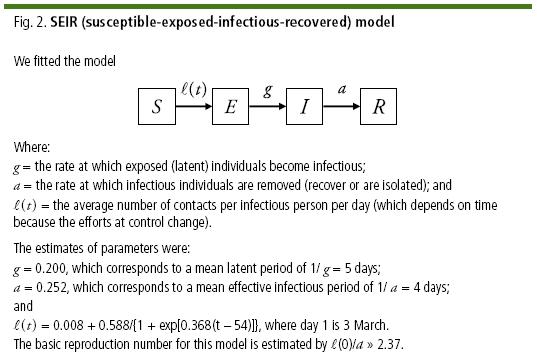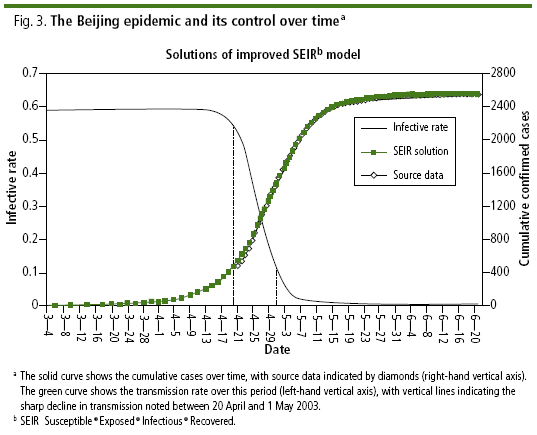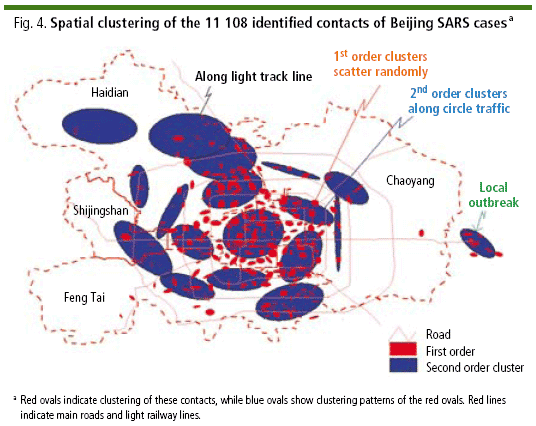RESEARCH
Spatial dynamics of an epidemic of severe acute respiratory syndrome in an urban area
Dynamique spatiale d'une épidémie de syndrome respiratoire aigu sévère (SRAS) dans une zone urbaine
Dinámica geográfica de una epidemia de síndrome respiratorio agudo severo en una zona urbana
Jinfeng WangI,1; Anthony J McMichaelII; Bin MengI; Niels G BeckerII; Weiguo HanI; Kathryn GlassII; Jilei WuIII; Xuhua LiuI; Jiyuan LiuI; Xiaowen LiIV; Xiaoying ZhengIII
IInstitute of Geographical Sciences and Natural Resources Research, Chinese Academy of Sciences, A11, Datun Road, Anwai, Beijing, 100101, China
IINational Centre for Epidemiology and Population Health, The Australian National University, Canberra, Australia
IIIInstitute of Population Science, Peking University, Beijing, China
IVInstitute of Remote Sensing Applications, Chinese Academy of Sciences, Beijing, China
ABSTRACT
OBJECTIVE: To map risk of exposure to severe acute respiratory syndrome (SARS) in an urban area and assess the ability of traditional interventions to control dispersion of the disease.
METHODS: Data on the Beijing SARS epidemic were used to map spatial clusters of identified contacts and to estimate transmission of SARS using a model with a time-dependent transmission rate.
RESULTS: The estimated transmission rate decreased dramatically from 20 to 30 April 2003. The total number of cases in the epidemic in Beijing was estimated to be 2521. Hierarchical clustering revealed that risk-exposures were widespread, but clustered in a pattern that is distinctly related to the Beijing urban ring roads.
CONCLUSION: Traditional control measures can be very effective at reducing transmission of SARS. Spatial patterns of risk-exposures can inform disease surveillance, prediction and control by identifying spatial target areas on which interventions should be focused.
RÉSUMÉ
OBJECTIF: Cartographier le risque d'exposition au syndrome respiratoire aigu sévère (SRAS) dans une zone urbaine et évaluer la capacité des interventions de type classique à endiguer la propagation de la maladie.
MÉTHODES: Les données de l'épidémie de SRAS de Beijing ont servi à cartographier les grappes spatiales de contacts identifiés età évaluer la transmission du SRAS au moyen d'un modèle utilisant un taux de transmission dépendant du temps.
RÉSULTATS: Le taux de transmission estimé a diminué très fortement entre le 20 et le 30 avril 2003. Le nombre total de cas dus à l'épidémie de Beijing a été évalué à 2521. Le regroupement hiérarchique en grappes de grappes a fait apparaître une zone d'exposition au risque très étendue. Néanmoins, les cas se regroupaient selon un schéma clairement lié aux voies de ceinture urbaine de Beijing.
CONCLUSION: Les mesures de lutte classiques peuvent réduire de manière très efficace la transmission du SRAS. Les schémas spatiaux d'exposition au risque peuvent fournir des informations utiles à la surveillance, à la prévision et à l'endiguement de la maladie en identifiant les zones spatiales cibles sur lesquelles les interventions devront se concentrer.
RESUMEN
OBJETIVO: Cartografiar el riesgo de exposición al síndrome respiratorio agudo severo (SRAS) en una zona urbana y evaluar la eficacia de las intervenciones tradicionales para controlar la dispersión de la enfermedad.
MÉTODOS: Se emplearon los datos sobre la epidemia de SRAS sufrida por Beijing para cartografiar los conglomerados geográficos de los contactos identificados y estimar la transmisión del SRAS mediante un modelo basado en una tasa de transmisión dependiente del tiempo.
RESULTADOS: La tasa de transmisión estimada disminuye drásticamente entre el 20 de abril y el 30 abril de 2003. El número total de casos provocados por la epidemia en Beijing se estimó en 2521. Los conglomerados jerárquicos revelaron que la exposición al riesgo era generalizada, pero se observaba una distribución de los casos claramente relacionada con las carreteras de circunvalación urbana de Beijing.
CONCLUSIÓN: Las medidas de control tradicionales pueden ser un arma muy eficaz contra la transmisión del SRAS, y las actividades de vigilancia, predicción y control de la enfermedad se pueden beneficiar de los modelos geográficos de riesgo-exposición, gracias a la identificación de las zonas en que deberían centrarse las intervenciones.

Introduction
As with many outbreaks of infectious disease, an epidemic outbreak of severe acute respiratory syndrome (SARS) such as that in 2003 could recur. Other similar infectious diseases could emerge equally unexpectedly. Recognition of this possibility has stimulated many studies of SARS, to determine its transmission characteristics and to assess the effectiveness of control measures.1-3 Few studies, however, have attempted to capture the spatial component in the epidemic data.4,5 This study has used geographical techniques to identify and map spatial patterns of risk-exposures, and mathematical modelling techniques to quantify the temporal spread of SARS in Beijing in the spring of 2003.
SARS was first seen in Guangdong, a southern province of China, at the end of 2002. On 1 March 2003, the first case of SARS was recorded in Beijing, the capital of China. Beijing is composed of 16 districts and two counties, with a population of 12.5 million distributed over 17 800 km², as shown in Fig. 1.
Methods
Data
Daily data on SARS cases in Beijing came from authorized daily reports, beginning on 20 April 2003 and continuing to the end of the epidemic in June 2003. Geographic Information System (GIS) data were obtained, giving the location of residences of all 11 108 close contacts of infected people, collected by exhaustive tracing of SARS cases both before and after 20 April. Other data relevant to the epidemic included population counts in 246 census units; information about the location of hospitals; and location of main traffic routes. The population density and the locations of the hospitals and traffic routes are indicated in Fig. 1.
Estimating parameters and temporal control of the epidemic A model was developed to describe epidemic transmission, assuming that individuals were likely to move through the Susceptible ® Exposed ® Infectious ® Recovered (SEIR) classes (Fig. 2).6-8 We fitted this model to the case incidence data over the period 19 April to 21 June 2003. The reduction in the number of susceptible individuals was ignored because the eventual number infected comprised a very small fraction of the total number of Beijing residents. We modelled the changes in control efforts by assuming that the transmission rate decreased over time. The fitted model provides estimates for the dates over which control measures improved, and the level of control achieved by the end of the epidemic. We estimated the total size of the epidemic using the area under the fitted curve of the number of infected individuals before 19 April and reported cases after that date.

Spatial distribution of identified contacts
The nearest neighbour hierarchical clustering9 technique was used to identify spatial patterns in the data, given the location of close contacts of identified cases. Points are circled as a spatial cluster if the distances between them were significantly smaller than the mean distance computed under the assumption that the points were distributed randomly over the space. First-order clusters indicate spatial clustering of high-risk susceptibles, and second-order clusters indicate regions with a high concentration of first-order clusters.
Results
Epidemiological parameters are essential characteristics of an epidemic, around which intervention strategies are based. Fig. 3 shows the fitted model of the epidemic for the number of infected individuals and the estimated transmission rate over the period 3 March-20 June 2003. The transmission rate shows a very rapid decline over the period 20-30 April. The average incubation period was found to be about 5 days, and the average effective infectious period about 4 days. Our estimate of the basic reproduction number (i.e. the average number of persons infected by a person carrying the infection) is 2.37, which is in agreement with estimates obtained in other locations.1-3 The eventual reproduction number, achieved by about 11 June, is estimated to have been 0.1, indicating that a dramatic reduction had been achieved. In particular, it is noteworthy that the transmission rate reached one-sixth of its initial value in the 10 days following 20 April. The estimated total size of the epidemic (i.e. number of cases of SARS in Beijing) obtained using the model was 2522, which is in close agreement with the figure of 2521 reported by the Beijing Government and WHO.10

The spatial distribution of risk of exposure to infection is clearly revealed by mapping data on the residences of 11 108 identified contacts of the people who were infected with SARS in Beijing. Nearest-neighbour hierarchical clustering9 was used to identify spatial structure in these data. Fig. 4 shows the first-order (micro-scale) clusters of high-risk susceptibles in red and the second-order (large-scale) clusters in blue against the background layers of population density by census unit and main traffic routes. Most of the first-order clusters are scattered within the third ring road, while the second-order clusters show an obvious looping pattern, and extend to the west and north-west. The model identified both first- and second-order clustering in the Tongzhou district at the easternmost section of the city, which saw two outbreaks of 17 and 9 cases of SARS in the later stages (7 May and 10 May respectively) of the epidemic.

Discussion
Our analysis of the temporal spread of SARS indicates that control measures led to a very rapid decline in the transmission rate after 20 April 2003. This is consistent with the fact that the threat from SARS was acknowledged in early April and from 20 April authorities substantially increased various approaches to control the outbreak.11 This suggests that the methods used to limit exposure to infectious agents were extremely effective for dealing with an infection with the epidemiological characteristics of SARS.
The strong visual association between the direction of the larger clusters and the ring roads and the light railway strongly suggest that focusing interventions along Beijing traffic routes is likely to be an effective strategy for the control of SARS or of diseases with similar epidemiological characteristics. Some possible interventions include: the closure of major traffic routes in the epidemic peak period; enhanced screening of populations along these transmission routes; sterilization of objects and facilities prone to harbouring the pathogen along commuter routes and distribution of information and guidance to potential travellers using the ring roads. 
Acknowledgements
We thank the Beijing Center for Disease Control and E Zhong and D Zhuang for preparing the data on SARS and other relevant information. The National Science Foundation of China and the Ministry of Science and Technology of China sponsored the study.
Competing interests: none declared.
References
1. Anderson R, Fraser C, Ghani A, Donnelly C, Riley S, Ferguson N, et al. Epidemiology, transmission dynamics and control of SARS: the 2002-2003 epidemic. Philos Trans R Soc Lond B Biol Sci 2004;359:1091-105.
2. Lipsitch M, Cohen T, Cooper B, Robins J, Ma S, James L, et al. Transmission dynamics and control of severe acute respiratory syndrome. Science 2003;300:1966-70.
3. Riley S, Fraser C, Donnelly C, Ghani A, Abu-Raddad L, Hedley A, et al. Transmission dynamics of the etiological agent of SARS in Hong Kong: impact of public health interventions. Science 2003;300:1961-6.
4. Haining R. Spatial data analysis: theory and practice. Cambridge: Cambridge University Press; 2003.
5. Keeling M, Woolhouse M, May R, Davies G, Grenfell B. Modeling vaccination strategies against foot-and-mouth disease. Nature 2003;421:136-42.
6. Kermack W, McKendrick A. A contribution to the mathematical theory of epidemics. Proc Roy Soc Lond Series A 1927;115:700-21.
7. Anderson RM, May RM. Infectious diseases of humans. Oxford: Oxford University Press; 1991.
8. Hamer WH. Epidemic disease in England. Lancet 1906;1:733-9.
9. Levine N. CrimeStat III: a spatial statistics program for the analysis of crime incident locations (version 3.0). Houston (TX): Ned Levine & Associates/Washington, DC: National Institute of Justice; 2004.
10. WHO. Update 87 - World Health Organization changes last remaining travel recommendation - for Beijing, China. Available from: http://www.who.int/csr/don/2003_06_24/en/
11. BBC. SARS Beijing. Available at: http://www.bbc.co.uk/worldservice/learningenglish/newsenglish/
witn/030421_witn.shtml
(Submitted: 18 January 2006 - Final revised version received: 15 May 2006 - Accepted: 24 May 2006)
1 Correspondence to J Wang (email: wangjf@igsnrr.ac.cn).
